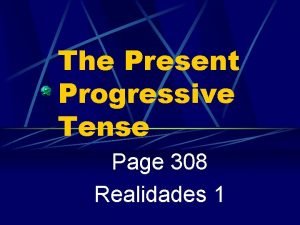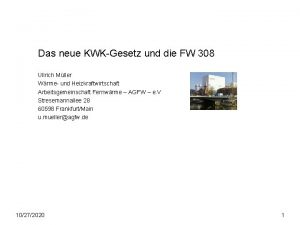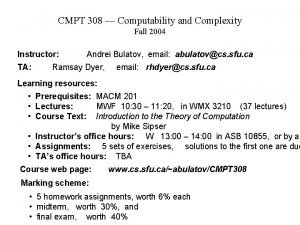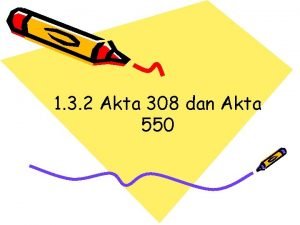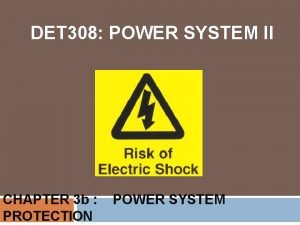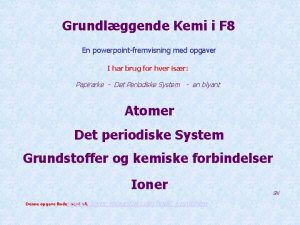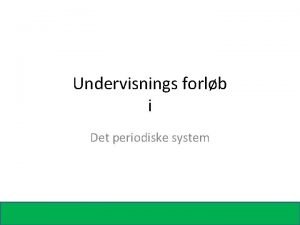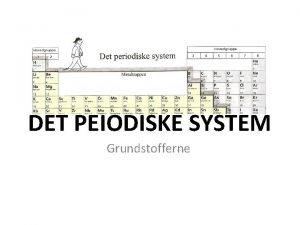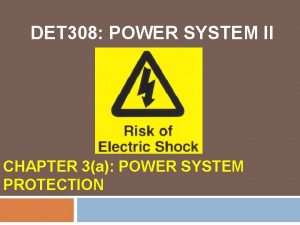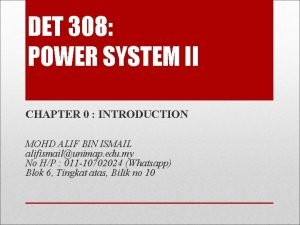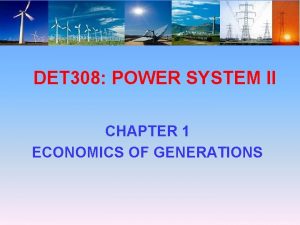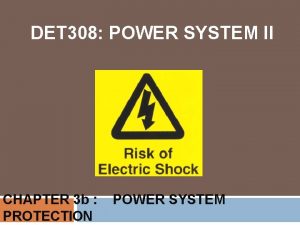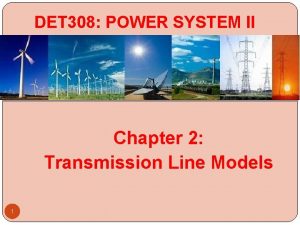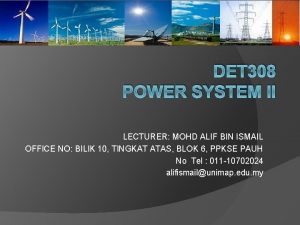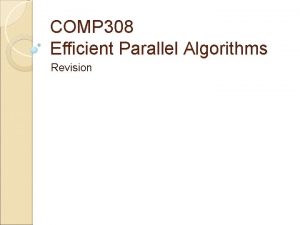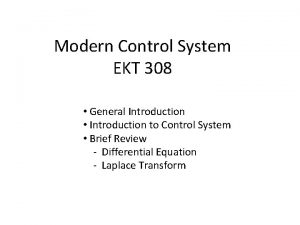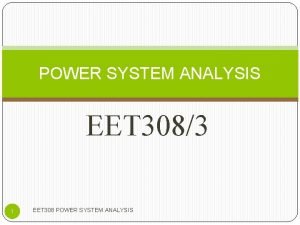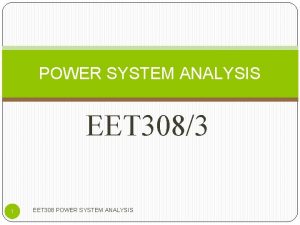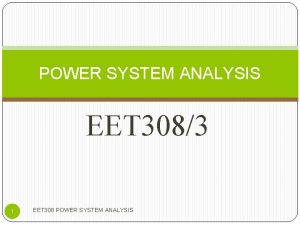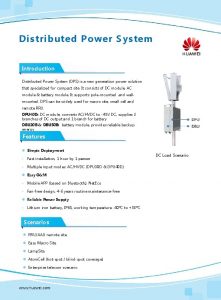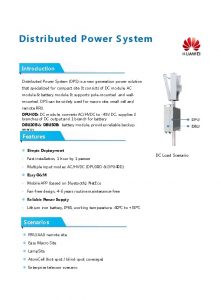DET 308 POWER SYSTEM II CHAPTER 4 INTRODUCTION


























- Slides: 26

DET 308 POWER SYSTEM II CHAPTER 4: INTRODUCTION TO COMPONENTS OF TRANSMISSION & DISTRIBUTION SYSTEM IN MALAYSIA

Introduction � The transmission of electrical energy does not usually raise as much interest as does its generation and utilization; consequently, sometimes tend to neglect this important subject � This is unfortunate due to basically human and material resource are actually involved in transmission are much greater compared to those employed in generation. � Electrical energy is carried by conductors such as overhead transmission lines and underground cable. � Although these conductors appear very common, they posses important electrical properties that greatly affect the transmission of electrical energy. � In this chapter, we will study the components of transmission and distribution especially in

Principle Components of a Power Distribution System �In order to provide electrical energy to consumers in usable form, a transmission and distribution system must satisfy some basic requirements. �Thus, the system must: ØProvide, at all times the power that consumers need ØMaintain the stable, nominal voltage that does not vary by more than +/- 10% ØMaintain a stable frequency that does not vary more than +/- 0. 1 Hz ØSupply energy at an acceptable price ØMeets standards of safety ØRespect environmental standards

�Figure 1 shows an elementary diagram of a transmission and distribution system. �It consists of two generating station G 1 and G 2, a few substations and interconnecting substation and a several commercial, residential and industrial loads. �The energy is carried over lines designated EVH, HV, MV and LV �This voltage classification is made according to scale of standardized voltages whose nominal values are given in Table 1

Figure 1: Single – line diagram of a generation, transmission and distribution syste

Figure 2: Overview of the electricity infrastructure

Table 1: Voltage classes as applied to industrial and commercial power

Table 2: Nominal System Voltage Class Nominal System Voltage Low voltage (LV) 120/240 V 1 k. V Medium voltage (MV) Up to 69 k. V High voltage (HV) Up to 230 k. V Extra High Voltage (EVH) Up to 765 k. V

�Electrical power utilities divide their power distribution systems into two major categories: ØTransmission system: in which the line voltage is roughly between 115 k. V and 800 k. V. ØDistribution system: in which the voltage generally lies between 120 k. V and 69 k. V. Distribution systems, in turns, are divided into MV distribution system (2. 4 k. V to 69 k. V) and LV (120 V to 600 V)

Supply Voltage Options � Supply may be provided at any of the declared voltages: ü 275 k. V, 132 k. V, 33 k. V, 22 k. V*, 11 k. V, 6. 6 k. V* and 415/240 V. ü Generally, supplies to domestic premises are given at single phase 2 -wire or three phase 4 wire. However, the actual supply voltage provided depends on the magnitude of the individual applicant’s load requirements: Low Voltage i. Single-phase, two-wire, 240 V up to 12 k. VA maximum demand ii. Three-phase, four wire, 415 V up to 45 k. VA maximum demand iii. Three-phase, four wire, C. T. metered, 415 V up to 1000 k. VA maximum demand.

Medium voltage and High Voltage: i. Three-phase, three-wire and 11 k. V for load of 1000 k. VA maximum demand above. ii. Three-phase, three-wire, 22 k. V or 33 k. V for load of 5000 k. VA maximum demand above. iii. Three-phase, three-wire, 66 k. V, 132 k. V and 275 k. V for exceptional large load of above 25 MVA maximum demand.

Components of HV Transmission Line �A transmission line is composed of conductors, insulators, surge protection and supporting structures.

A. Conductors � A wire is metal drawn or rolled to long lengths, normally understood to be a solid wire. Wires may or may not be insulated. A conductor is one or more wires suitable for carrying electric current. Often the term wire is used to mean conductor. � Most conductors are either aluminium, copper and steel cored aluminium. Utilities use aluminium for almost all new overhead installations. � Aluminium is lighter and less expensive for a given current-carrying capability. Copper was installed more in the past, so significant lengths of copper are still in service on overhead circuits. � Copper has very low resistivity and is widely used as a power conductor, although use as an overhead conductor has become rare because copper is heavier and more expensive than aluminium. It has significantly lower resistance than aluminium by volume.

� Steel cored aluminium – due to low tensile strength, aluminium conductors produce greater sag. To increased the tensile strength, the aluminium conductor is reinforced with a core of galvanized steel wires. � Electrical energy is carried by conductors such as overhead transmission lines and underground cable. � Several variations of aluminium conductors area available: ◦ ◦ AAC – all aluminium conductor ACSR – aluminium conductor steel reinforced AAAC – all aluminium alloy conductor ACAR – aluminium conductor, alloy reinforced

�Classification of underground cables divided in 2 ways according to: �Type of insulating material used in their manufacture. �The voltage for which they are manufactured. �The main part of underground cables are: ◦ Conductor: copper or aluminium ◦ Insulating material: rubber, oil-impregnated paper, gas etc ◦ Protective sheath: steel, jute covering

B. Insulator � To provide necessary clearance between conductors and metal works , the conductors are attached to insulators. � Also provides mechanical support for the conductor. � The most suitable materials for insulators are: v. Toughened glass v. Porcelain � Types Of Insulators: ◦ ◦ Pin type insulator Suspension type insulator Strain insulator Shackle insulator

C. Surge Protection �A surge protector is an appliance designed to protect electrical devices from voltage spike. A surge protector attempts to limit the voltage supplied to an electric device by either blocking or by shorting to ground any unwanted voltages above a safe threshold

D. Supporting Structure � The supporting structure which is called line support must keep the conductors at a safe height from the ground at an adequate distance from each other. � The line supports are poles and the chief requirements for such supports are : ◦ They must be mechanically strong with factor of safety of 2. 5 to 3 . ◦ They must be light in weight without the loss of strength. ◦ They must have least number of parts ◦ They must be cheap ◦ Their maintenance cost should be minimum ◦ They must be easily accessible for point and erection of line conductors. ◦ They must have longer life ◦ They must be of pleasing shape

� Type of line supports: ◦ ◦ Wooden poles Steel poles Concrete poles Steel tower For voltages below 70 k. V, we can use single wooden poles equipped with two cross-arms, but for higher voltages, two poles are used to create H-frame. � For HV lines, steel towers are used, made of galvanized angleiron pieces that are bolted together. � The spacing between conductors must be sufficient to prevent arcover under gusty wind conditions. The spacing has to be increased as the distance between towers and as the line voltages become � Figure 3: Single phase singlecircuit

Transmission Tower 1. Suspension insulator set 2. Phase conductor 3. Spacer between two conductors of the same phase 4. Shield conductor 5. A set of three phase conductors 6. Identification plate 7. Security feature against unauthorised climber.

General Classifications / Topology of Power Distribution Systems � There are three classifications: ◦ Radial system ◦ Ring system ◦ Network system A. Radial System ◦ The simplest of all distribution networks. ◦ A single substation supplies power to all loads in the system. Load 1 Substation Load 2 Power lines Load 3 Load 4 Figure 4: Radial power-transmission system

B. Ring System ◦ Distribution lines encircle the service area with power being delivered from one or more sources into substations near the service area. ◦ Power is then distributed from the substations through the radial transmission lines. Power lines Substation Load 4 Load 1 Load 2 Load 3 Figure 5: Ring power-transmission system

C. Network System ◦ A combination of the radial and ring distribution system. Although such a system is more complex than either of the previous configurations, reliability is improved significantly. ◦ The network system, illustrated in figure below is one of the most common power distribution configurations. Power lines Substation Load 1 Load 2 Load 3 Load 4 Load 5 Figure 6: Network power-transmission system

Substation � Substations are used throughout an electrical system. Starting with the generation station, a substation raises the MV generated by the synchronous generators to the high voltage needed to transmit the energy economically. � The high transmission line voltage is then reduced in those substations located to the power consuming centers. � The electrical equipment in such distribution substations is similar to that found in substations associated with generating plant. � A substation: ◦ ◦ It should be located at proper site It should provide safe and reliable arrangement It should be easily operated and maintained It should have minimum capital cost.


 Det beskrivende og det komplekse kulturbegreb
Det beskrivende og det komplekse kulturbegreb De fem pelarna islam
De fem pelarna islam Triangle of power
Triangle of power The present progressive tense page 308
The present progressive tense page 308 Pekeliling pemeriksaan mengejut ap 309
Pekeliling pemeriksaan mengejut ap 309 Fw 308
Fw 308 Bot 308
Bot 308 Cmpt 308
Cmpt 308 Surat seksyen 308
Surat seksyen 308 5 sinf ona tili 326 mashq
5 sinf ona tili 326 mashq Bot 308
Bot 308 Arc 308
Arc 308 308
308 Sec 308
Sec 308 Site:slidetodoc.com
Site:slidetodoc.com 2cfr200.308
2cfr200.308 Power angle curve in power system stability
Power angle curve in power system stability Janus ravn psykiater
Janus ravn psykiater Hvor i det periodiske system står atomer med 5 skaller?
Hvor i det periodiske system står atomer med 5 skaller? Atomets historie
Atomets historie Det periodiske system hovedgrupper
Det periodiske system hovedgrupper Solar power satellites and microwave power transmission
Solar power satellites and microwave power transmission Potential power
Potential power Flex28024a
Flex28024a Unit of dispersive power
Unit of dispersive power Power of a power property
Power of a power property General power rule
General power rule



